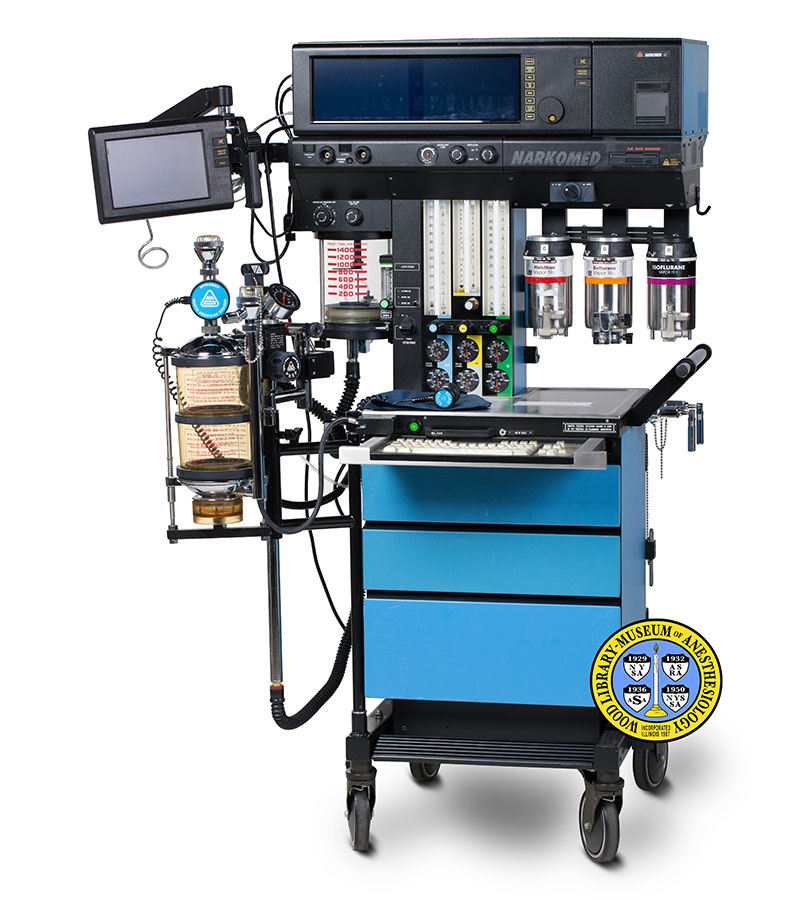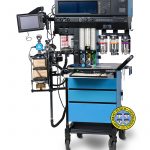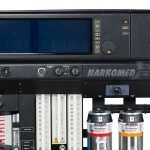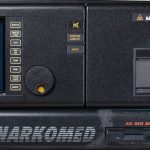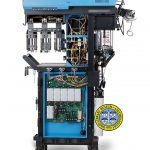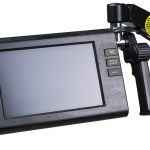Narkomed 4
The Narkomed 4, manufactured by North American Dräger (NAD), was introduced in 1990. Differences between it and the Narkomed 3 were especially notable in the design of the onboard computer. The Narkomed 4 included dual processors, a built-in 3.5 inch floppy disk drive, a keyboard, and a dual display touch screen.
The new software was named “O.R. Data Manager” (ORDM). Information that the software could record was limited to numerous predetermined “pick lists” and short fill-in-the-blank fields. ORDM allowed anesthesia providers to create patient records, add patient biographical data, and document basic case information, core events (start of anesthesia, start of surgery, patient exiting OR, etc.), and medication and fluid administration. Data from the machine’s monitors was automatically entered into the record every 30 seconds. The patient record could be saved to a floppy disk or to a network drive disk. During the 1990s completed records were often printed, augmented and added to the patient's paper record.
Six monitors sent data to the ORDM and the display screen. The variables monitored were inspiratory oxygen concentration, pulse oximetry, respiratory volume, respiratory gas concentrations (carbon dioxide, nitrous oxide, and anesthetic agents), breathing system pressure, and blood pressure.
NAD reported that more than 100,000 engineering hours were invested in the design of the Narkomed 4. The donation of the machine pictured here was facilitated by a former NAD machinist and educator, Mr. James Yoder.
Catalog Record: Narkomed 4
Access Key: ammd
Accession No.: 2014-02-15-1 G
Title: Narkomed 4 / North American Dräger.
Corporate Author: North American Dräger.
Title variation: Alt Title
Title: Narkomed 4 anesthesia system.
Publisher: Telford, PA. : North American Dräger, [between 1990 and 2000?].
Physical Descript: 1 anesthesia machine : metals, plastics, rubber, glass ; 166 x 149 x 139 cm.
Subject: Anesthesia Machines – computerized.
Subject: Anesthesia, Inhalation – instrumentation.
Subject: Halothane.
Subject: Enflurane – instrumentation.
Subject: Isoflurane.
Subject: Vaporizers.
Subject: Monitoring, Intraoperative – instrumentation.
Note Type: General
Notes: The early year in the date range for the possible year of manufacture is
based on the earliest date found for a Narkomed 4 manufacturer’s publication,
and the earliest advertisement found for the Narkomed 4. The late date in the
range for the possible year of manufacture is a generous estimate based on
the year that the Narkomed GS was introduced (1997).
Note Type: Citation
Notes: Emails from George Bause, MD. Accession record 2014-02-15-1 G. Archives.
Located at: Located at: Wood Library-Museum of Anesthesiology, Schaumburg,
Illinois.
Note Type: Citation
Notes: Day in the life. 24×7 website. https://www.24x7mag.
com/2007/01/day-in-the-life-drger-museum/. Published January 31, 2007.
Accessed October 16, 2015.
Note Type: Not Applicable
Notes: Narkomed 3 [marketing booklet]. Telford, Pennsylvania: North American Dräger;
1986.
Note Type: Citation
Notes: Narkomed 4 anesthesia system: operator’s instruction manual. Telford,
Pennsylvania: North American Dräger; 1999.
Note Type: Not Applicable
Notes: Narkomed 4 [marketing booklet]. Telford, Pennsylvania: North American Dräger;
1990.
Note Type: Citation
Notes: Narkomed: an integral part of the operating room [marketing booklet]. Telford
Pennsylvania: North American Dräger; 1996.
Note Type: Citation
Notes: North American Dräger. In a class by itself: Narkomed 4 [advetisement].
Anesthesiology. 1990;73(4):[pages 53-55 of ads].
Note Type: Citation
Notes: Rendell-Baker L. The care of anesthesia equipment. In: Waugaman WR, Foster SD
Rigor BM, eds. Principles and Practice of Nurse Anesthesia. 2nd ed. Norwalk,
Connecticut: Appleton & Lange; 1992:152.
Note Type: Physical Description
Notes: [1] One anesthesia machine; The measurements in the physical description
field were taken with the arm for the remote display monitor extended into a
potion as if it were in use; The width of the machine excluding the remote
monitor and its arm is approximately 106 cm; The depth of the machine
excluding the remote monitor and arm is approximately 88 cm; Beginning at the
top left is a monitor panel, wide enough for two display screens; To the
immediate left of the monitor screen is a vertical column of rectangular
buttons; From top to bottom, these are marked in orange, “MONITOR”, “MONITOR
SETUP”, “DATA”, “DATA LOG”, “TREND”, “PRINT”, “SYSTEM CONFIG”, “BACKUP”; To
the right of this is a selection dial with an orange colored finger
depression; Above and to the right of the dial are three vertically stacked
rectangular buttons; From top to bottom they are marked with an alarm crossed
out, “VENTILATION ALARMS OFF”, “AUTOSET”; To the left of the monitor panel is
a built in thermal printer; The paper roll size might be 2 and ¼, or 3 and
1/8; Above the opening for the paper roll, in the upper right corner of the
machine is the North American Dräger logo and the text, “NARKOMED 4”; Just
below the monitor panel, on the left are some of the controls for the
ventilator; Marked most left is, “AV2+”; The controls are lined horizontally,
from left to right: A small digital screen and dial marked, “FREQUENCY [new
line] /min”, another small digital display and dial marked, “I:E RATIO”; The
actual turn buttons for the dials are missing; Below the display for the I.E
ratio is a button marked, “EXTENDED RANGE”; A few inches to the right is a
gauge and then a dial marked, “INSPIRATORY FLOW”; The gauge is marked with
three different sections labeled, “Low”, “Med”, and “High”; To the right of
the inspiratory dial are two small indicator lights; The upper light is
marked “VENTILATOR [new line] ON”; The lower light is marked, “FAULT”; To the
right of this the ventilator on-off control dial is, “NARKOMED”, marked in
large lettering; To the right of this lettering is an opening for a floppy
disk; The remainder of the ventilator controls are on the left side, below
those just described; They include a dial marked, “INSPIRATORY PRESSURE
LIMIT”; To the right of this is a dial marked “TIDAL VOLUME [new line] PUSH
TO TURN”; Below these is the bellows canister; To the right of the bellows
canister are four indicator lights; From top to bottom, these are marked, “O2
SUPPLY PRESSURE”, “AC POWER FAIL”, “BATTERY LOW”, “BATTERY TEST”; Below the
indicator lights is the system power dial with a position marked, “ON,” and
another position marked “STANDBY”; To the right of these lights and dials is
the gas flowmeter and pressure gauge assembly; Both nitrous oxide (marked
“N20” and color coded blue) and oxygen (marked O2 and color coded green) have
a coarse and fine flow tube, as well as pressure gauges for pipe and cylinder
sources; Between the nitrous oxide (on the left) and oxygen (on the right) is
a flowmeter for air (color coded yellow with calibration marks from .2 to 10)
and a flow meter for carbon dioxide (colored yellow and marked “CO2” with
calibration marks from .05 to 1.0); Each of these flowmeters has one
corresponding pressure gauge below the flowmeters; To the right of the
flowmeter assembly are the vaporizers; There are three Vapor 19.1 vaporizers
attached to the back bar; From left to right they are, “Halothan” (with a
color code bar of red), “Enflurane” (with a color code bar of orange), and
“ISOFLURANE” (with a color code bar of purple); Just above the three
vaporizers is a dial with two settings; One is marked, “02 + N20” and the
other is marked “ALL GASES”; Most of the housing of the machine thus far
described (located above the table top) is black, with the exception of the
sides which are Dräger blue; … [continued at 2].
Note Type: Not Applicable
Notes: [2, continued from 1] … The table top is stainless steel; A white sticker
on the table top is marked, “FOR NAD EDUCATION USE ONLY [new line] NOT FOR
CLINICAL USE”; On the front edge of the table top is a button for O2 flush
and a fresh gas outlet for a fresh gas oxygen sensor, as well as a handle,
and a port for a “BP BULB”; Below these is a pull-out shelf that holds the
keyboard for the OR Data Manager System; Below these are three drawers; A
check list for before use, and during use, is located on the inside bottom of
the fist drawer; The drawers and the sides of the bottom portion of the
machine are ‘Dräger’ blue; The machine is on four wheels; Extending from the
left side of the machine is the breathing system which includes, a dual
absorber canister, PEEP controls, a manual/automatic ventilation selector,
visible inspiratory and expiratory valves, a breathing system pressure gauge,
and oxygen sensor; Also extending from the left side of the machine is an
adjustable arm for the remote monitor; On the back of the monitor is a
manufacturer’s label with the following markings: “NORTH AMERICAN DRÄGER [new
line] 148B Quarry Road [new line] Telford, PA. 18969 USA [new line] MODEL
411 2314 [new line] SER. NO. 10733; On the left upper side of the machine are
a number of ports for monitoring equipment, including the port for the
“DATAGRIP” for the remote monitor, a port for the remote monitor itself, a
dual blood pressure cuff and blood pressure gauge, oximeter sensor, and
another BP cuff port; Further back, on the upper left side of the machine, is
a space for a water trap; Additional ports are located on the left side of
the machine below the ventilator bellows; They include oxygen sensor, volume
sensor, breathing pressure and selector/exhaust; An open reservoir scavenger
is located on the lower back of the left side of the machine; The body of the
scavenger is cream colored; Most of the panels on the back of the machine
have been removed to expose the computer components and the anesthesia system
components; Because of this, the model number for the machine is not on the
back; Power outlets are located on the upper left back of the machine; On the
upper right of the back of the machine is the external communication
interface panel; This contains connections for external monitors or a
centralized monitoring system; On the inner side of the flowmeter assembly,
along the back edge are three diameter index safety system connections for
pipeline gases; Two yokes for N20 and one yoke for air are also located on
the back of the machine; The power cord is wound around a hook on the lower
right back of the machine; On the right side of the machine are two yokes for
oxygen (one is missing the label); Extending from the right side of the table
top is a horizontal bar to steer the machine while moving it.
Note Type: Actions
Notes: Donated to the WLM by Mr. James Yoder.
Note Type: Reproduction
Notes: Photographed by Mr. Steve Donishe in June, 2015.
Note Type: Historical
Notes: The Narkomed 4, manufactured by North American Dräger (NAD), was introduced
in 1990. Differences between it and the Narkomed 3 were especially notable in
the design of the onboard computer. The Narkomed 4 included dual processors,
a build-in 3.5 inch floppy disk drive, a keyboard, and a dual display touch
screen.
The new software was named “O.R. Data Manager” (ORDM). The information that
the software could record was limited to numerous predetermined “pick lists”
and short fill-in-the-blank fields. ORDM allowed anesthesia providers to
create patient records, add patient biographical data, and document basic
case information, core events (start of anesthesia, start of surgery, patient
exits OR, etc.), and medication & fluid administration. Data from the
machine’s monitors was automatically entered into the record every 30 seconds
The patient record could be saved to a floppy disk or to a network drive
disk. During the 1990s completed records were often printed, augmented and
added to the patient’s paper record.
Six monitors sent data to the ORDM and the display screen. The variables
monitored were inspiratory oxygen concentration, pulse oximetry, respiratory
volume, respiratory gas concentrations (carbon dioxide, nitrous oxide, and
anesthetic agents), breathing system pressure, and blood pressure. Patient
temperature, which had been incorporated into the Narkomed 3, was omitted in
the Narkomed 4. A variety of interface controls (touch-screen, push buttons,
rotary dial, keyboard and remote monitor “datagrip”) could be used to adjust
what data was displayed, as well as how it was displayed.
Also new to the Narkomed with the Narkomed 4 was a strip printer, data ports
for external NAD devices and network connection, and a back-up battery.
NAD reported that more than 100,000 engineering hours were invested into the
design of the Narkomed 4. The GS described here was once part of the James
Yoder Teaching Collection of North American Dräger. Mr. Yoder was a NAD
machinist and educator. Originally Mr. Yoder maintained the collection of NAD
equipment for the purpose of educating anesthesia providers and machine
technicians. Later the collection was used to form the museum, which was
located at the headquarters of NAD in Telford, Pennsylvania.
Note Type: Exhibition
Notes: Selected for the WLM website (noted October 2, 2015).
